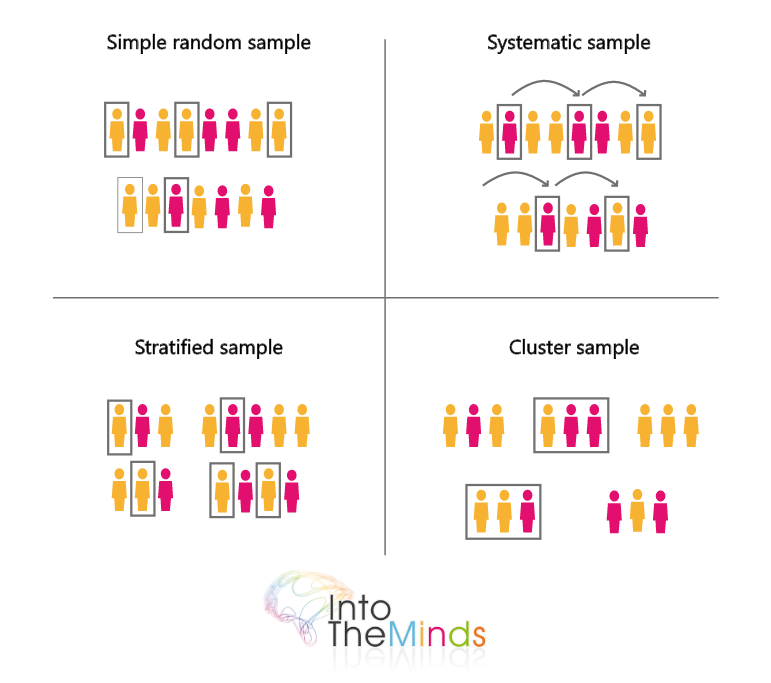Conducting market research involves selecting participants for the numerous studies to be carried out, whether qualitative or quantitative. These samples can be either probabilistic or non-probabilistic. This article will help you understand the diverse types of sampling, their differences, and their applications. We’ll start by looking at random approaches, most used in surveys. In the second part, we’ll look at non-random methods, the basis of all (but not all) qualitative research. In the middle of this article, you’ll find a graphic representation of the distinct types of probability sampling.
Contact us to conduct your surveys and qualitative research
If you only have 30 seconds
- There are 2 main types of sampling: random (probabilistic) and non-random (non-probabilistic).
- In qualitative research, only non-random methods are used. In most cases, sampling is used to explore a phenomenon.
- Survey institute soften use the quota approach. This applies to both B2C and B2B surveys.
Why conduct sampling?
Simply put, it’s impossible to survey an entire population in qualitative or quantitative research. Sampling is, therefore, essential if your results are to be dependable. However, we’ve found that more attention should be paid to the type of sampling chosen for a given objective. That’s why we’ve written this article.
More attention should be paid to the type of sampling chosen concerning the objective pursued.
Random sampling
Random sampling is essential for anyone wishing to conduct a reliable survey. It ensures unbiased results by giving each member of the population an equal chance of being selected. There are 4 types of random sampling.
Simple random sampling
Simple random sampling ensures that every member of the population has an equal chance of being included in the sample. The process is comparable to a lottery: each population element is assigned a unique number, and then a random number is chosen. This guarantees impartiality, minimizes bias, and enables accurate inferences about the entire population. Simple random sampling is widely used because of its ease of implementation and ability to produce representative samples.
Systematic sampling
This method involves selecting elements of the population at regular intervals, determined by a selection step. The starting point is usually chosen at random. This technique is particularly useful when a homogeneous population and a complete list are available. There is, however, a (limited) risk of bias if a certain periodicity exists within the population and corresponds to the selection interval. We must research the ideal step size for the population under study to implement this method correctly.
Stratified sampling
Before sample selection, this approach divides the population into homogeneous sub-groups, known as strata. Each stratum is a distinct group with similar characteristics. Sampling is then conducted separately in each stratum. This approach ensures that each sub-group is adequately represented in the final sample. Stratified sampling is particularly useful when strata have different variances, reducing sampling error and improving the precision of estimates compared with simple random sampling.
Cluster sampling
This technique is useful when the target population is large and inaccessible. Instead of selecting each population element individually, cluster sampling divides the population into groups, or “clusters,” often based on geography or other natural characteristics. Some of these clusters are then randomly selected for the survey. All individuals within the selected clusters are included in the sample. This method is advantageous for its simplicity and cost-effectiveness but can be biased if the clusters do not represent the entire population. This probabilistic method should be distinct from the quota method.
Non-random sampling
Non-random sampling techniques still need to be more in evidence (if not dominant) in market research. Here again, there are 4 main types.
Convenience sampling
This method is much more widespread than you might think (see our full article). It consists of selecting elements based on their immediate availability or simplicity of access. There is, therefore, no guarantee of representativeness, which explains why convenience sampling is used in exploratory approaches (qualitative surveys, for example). Finally, a convenience sample cannot be used to generalize results.
Quota sampling
Quota sampling involves deliberately selecting individuals according to predefined characteristics that reflect the target population. This method is widely used in opinion surveys, as well as in market research. Characteristics are usually age, gender, education, revenue, etc., based on their distribution in the total population. In practice, we usually work with “classes”. The most used age classes are, for example, 18-24, 25-34, 35-44, 45-54, and>55.
Participants are then selected until the quotas for each category are filled. This method enables data to be collected quickly and economically while allowing flexibility in the choice of participants. However, it can be subject to bias if quotas are not well defined or if individuals are poorly selected.
Purposive sampling
Purposive sampling relies on the researcher’s judgment to select the most relevant or informative cases to the research objective. This method is often used when researching complex phenomena. The researcher chooses targets according to their ability to deliver interesting information. For non-experts, the selection of interesting profiles can be conducted based on a literature review.
Purposive sampling will be used in exploratory settings but cannot yield generalizable results.
Snowballing
This qualitative research technique is used to research hard-to-reach populations. It starts with a small group of known participants and expands through their referrals. Each participant recruited refers to others, creating a “snowball” that increases in size.
This method is particularly useful for accessing closed or marginal communities where members know and trust each other. Although economical and practical, it can introduce biases, as samples are not random and may not represent the entire population. Despite this, snowballing remains valuable for exploring little-known or sensitive phenomena.
Posted in Marketing.
